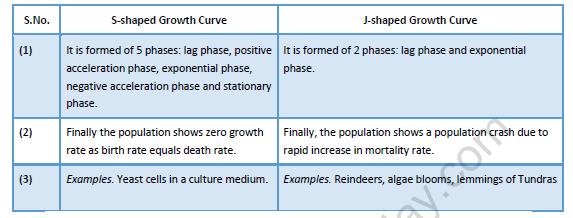Organisms and Population
Population Dynamics
(1) Population density:
(i) Population density is the number of individuals present per unit area or volume at a given time.
(ii) For instance, number of animal per square kilometer, number of trees per area in a forest, or number of plank tonic organism per cubic meter of water.
(iii) If the total number of individuals is represents by letter N and the number of units of space by Letter S, the population density D can be obtained as D=N/S.
(iv) Space is indicated in two dimensions (m2) for land organisms, and in three dimensions (m3) for aquatic organisms and for the organisms suspended in space.
(2) Birth rate or Natality:
(i) The birth rate of a population refers to the average number of young ones produced by birth, hatching or germination per unit time (usually per year).
(ii) In the case of humans, it is commonly expressed as the number of births per 1000 individuals in the population per year.
(iii) The maximum birth rate of a species can achieve under ideal environmental conditions is called potential natality.
(iv) The actual birth rate under the existing conditions is much less. It is termed realised natality.
(v) Crude birth rate is the number of births per 1000 persons in the middle of a given year i.e. on July.
(vi) Natality increases the population size (total number of individuals of a population) and population density.
(3) Death rate or mortality:
(i) The death rate of a population is the average number of individuals that die per unit time (usually per year).
(ii) In humans it is commonly expressed as the number of death per 1000 persons in a population per year.
(iii) Lowest death rate for a given species in most favourable conditions is called potential mortality, while the actual death rate being observed in existing conditions is called realized mortality.
(iv) Crude death rate is the number of deaths per 1000 persons in the middle of a given year i.e. on July.
(v) Mortality decreases the population size and population density both.
Difference between Natality rate and Mortality rate

(4) Vital index:
The percentage ratio of natality over mortality is known as vital index i.e. natality / mortality×100. It determines the growth of a population.
(5) Immigration:
It is permanent entry of additional person into the existing population of a country or region from outside. Example; Many Nepalese and Chinese come to settle in India.
(6) Emigration:
(i) It is the permanent departure of some persons from the existing population of a region to a different state or a foreign country. Example; Many Indians go to Western countries to settle there.
(ii) Immigration and emigration bring about redistribution of population, and are common in animals.
(iii) The se occur for various reasons, such as search for food, escape from competition due to overcrowding, need of shelter etc.
(7) Sex ratio:
The number of females in a population per 1000 males is called sex ratio.
Sex ratio = No. of females/ 1000(males)
(8) Age structure:
(i) The age structure of a population is the percentage of individual of different ages such as young, adult and old.
(ii) Age-sex structure of a population can be shown by a pyramid-like diagram by plotting the percentage of population of each sex in each age-group.
Patterns of Population Growth:
Growth of a population can be expressed by a mathematical expression, called growth curve in which logarithm of total number of individuals in a population is plotted against the time factor.Growth curves represent interaction between biotic potential and the environmental resistance.
Two basic types of growth curves:
(a) Sigmoid or S-shaped growth curve: It is shown by yeast cells and most of organisms. It is formed of five phases:
(1) Lag phase. In which the individuals adapt themselves to the new environment, so there is no or very little increase in population.
(2) Positive Acceleration phase. It is the period of slow increase in population in the beginning.
(3) Logarithmic or Exponential phase: It is the period of rapid rise in population due to availability of food and requirements of life in plenty and there being no competition.
(4) Negative Acceleration phase: In which again there is slow rise in population as the environmental resistance increases.
(5) Stationary (Plateau) phase: Finally, growth rate becomes stable because mortality and natality rates become equal to each other. So there is zero growth rate. A stable population is said to be in equilibrium, or at saturation level. This limit in population is a constant K and is imposed by the carrying capacity of the environment. S-shaped curve is also called logistic curve. Sigmoid growth curve was described by Verhulst, (1839)
(b) J-shaped Growth curve: It is shown by small population of Reindeer experimentally reared in a natural environment with plenty of food but no predators. It has only two phases:
(1) Lag phase: It is period of adaptation of animals to new environment so is characterized by slow or no growth in population.
(2) Logarithmic or Exponential phase: It is characterized by rapid growth in population which continues till enough food is available. But with the increase in reindeer population, there is corresponding decrease in the availability of food and space, which finally become exhausted, which leads to mass starvation and mortality. This sudden increase in mortality is called population crash. Lemming of Tundra, some insect, algal blooms and annual plants also show J-shaped curves. The population growth curve is S- shaped in most of the organisms, Human population also shows S-shaped curve.
Difference between S-shaped and J-shaped Growth curves

Please click the link below to download pdf file of NEET Biology Environment and Ecosystem Revision Notes

